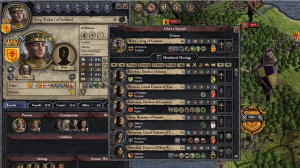Trending
Opinion: How will Project 2025 impact game developers?
The Heritage Foundation's manifesto for the possible next administration could do great harm to many, including large portions of the game development community.

Featured Blog | This community-written post highlights the best of what the game industry has to offer. Read more like it on the Game Developer Blogs or learn how to Submit Your Own Blog Post
The Game Industry became a lot more accessible over the last decade, and part of that was a decision to abstract design and mechanics. Today's post looks at what that means and one of the best examples of it in action.

I've talked about how games have become more accessible countless times due to a variety of reasons. For today's post, I want to talk about the greater role that abstracted mechanics and game design have had to make it easier to learn games, and why some genres are still having trouble broadening their audience.
More...

XCOM 2
In every video game there is a layer of abstraction at play; the game designer's ways of showing concepts at a more streamlined layer. This can be everything from how health works in a game, breaking down stealth mechanics and so much more.
The point is that instead of showing the player dozens of numbers and formulas, things are abstracted so that the player is shown the surface layer of how the mechanic works, while the game itself does all the major calculations at the low level.
For instance, let's say that a stealth system measures the lighting around the player, the enemy's perception rating, the player's own detection rating and creates a formula to determine how close the player has to be before they are spotted. Instead of showing all those numbers to the player, the game can instead just have a visual indicator on the map or UI that shows where the player will be detected.

Crusader Kings 2, originally posted on Kotaku
Many strategy games have problems with presenting the depth of their mechanics, without the complexity that makes them so difficult to understand.What makes abstraction work is that it allows the game designer to have their cake and eat it too: They can make complicated games with challenging mechanics and systems, but presents them to the player in an easy to follow way that doesn't reduce the depth, but simply the complication.
Talking about abstraction and game design, we have to touch on the change in design philosophy between the late 80's-90s and the 00's.
Many fans of older games agree that there was a lot of depth to PC games from the 80's through 90's; a major reason why so many people love GOG and their catalog. Series like Might and Magic, Age of Wonders, X-Com and so many CRPGs offered hours of in-depth gameplay and design.
On one hand, this is what has led to these games achieving classic status and are still being played by their fans today. On the other hand, they are notoriously difficult for someone new to get into; even beyond the UI and different control schemes. Despite featuring abstraction in the form of dealing with fictional settings and powers, these games make very little attempt at hiding their numbers, mechanics and low level thinking behind them.
The CRPG genre for example achieved a huge audience and boom in the late 90's and 00's thanks to moving the calculations of playing a pen and paper game to the engine instead of having the player do it. With that said the genre still shows all the variables and numbers and can be very hard for someone new to jump into.

Civilization 5, originally posted on 2kgames.com
Firaxis' strategy games have depth to them, but featured abstracted systems and UI to help someone new make sense as to what's going on.The change in game design standardization and abstraction in the 00's has led to this debate of complexity vs. complication.
Many older fans feel that removing the low level information from the player has robbed them of their depth; while others feel that older games were simply complicated for the sake of complexity and not for deep systems.
Personally, I think the greater use of abstraction has led to a lot of games being enjoyed by more people and I have what is becoming my go-to game example to talk about why.
Firaxis is considered to be one of the most successful studios when it comes to the strategy genre for more than two decades, with the Civilization series standing as one of the best. The trick to Firaxis' success has been their ability to carefully balance depth and abstraction: Creating systems and UI that are presented very easily, but to paraphrase Sid Meier, still have interesting decisions for the player.
Instead of filling screens with all kinds of data for the player to sift through, the Civ series abstracts important concepts into easy to follow symbols and low value variables. The beauty of this is that the games still present depth and challenge to the player, but they're easy to follow thanks to the abstracted nature.
Nowhere is this more present than XCOM Enemy Unknown and recently XCOM 2. I've talked enough about XCOM in the past, so I won't be going into detail here. However, I do want to touch on how Firaxis streamlined the complexity of the series. Many people call Enemy Unknown: A modern take on X-Com and that title is deserved. While Enemy Unknown has the same DNA as the original, many of X-Com's complex mechanics and rules have been stripped out and/or redefined to be more accessible.
Inventories are a lot smaller, the number of squaddie stats has been condensed and there is the big example: Time Units replaced by a two action per unit combat system. The series' M.O. of tough choices and the challenge of keeping your troops alive are present, but it's presented a lot more elegantly compared to other strategy games and the earlier X-Coms.

XCOM 2
XCOM EU and XCOM 2 keep the same basic formula of X-COM, but updated the rules and system for newcomers to understand.Again, numerical values are kept low and abstracted to make them easier to understand. For example, having a unit lose 5 of their 10 points of health is just as tense as having someone lose 32 of their 64 points, but it's quicker to process; the same with low numerical values for credits and item costs.
Even the act of attacking an enemy has been streamlined: Breaking down the player's attack stats versus the enemy's defense modifiers to calculate the to-hit percent.
Was Enemy Within streamlined too much from the original? We could argue that, but that is a discussion for another time.
Abstracting mechanics and numbers has become fundamental in the industry becoming more accessible to a greater audience over the last two decades. More importantly, this has represented a major shift in game design standardization; people don't expect to spend hours learning your game anymore.
A good game should be easy to learn; not require 10 hours of tutorials, videos and let's plays to figure out. You can still have complexity and deeper mechanics, but a great game designer in the modern market can abstract that for the audience playing. While you can find success with games that don't hide or abstract the mechanics, it will no doubt limit the reach of your game.
Even a difficult game like the Darkest Dungeon has had time and energy spent on UI design to help abstract and show what's going on to someone of any skill level; yet there is still depth to the mechanics for someone to figure out.
There is a lot more we can talk about in terms of making games more accessible through clever UI and design changes, but we would just be repeating points presented here and in other posts. Being able to view your game through the eyes of a newcomer as well as a veteran is key to understanding how your game is being processed and being able to balance depth and accessibility is an important skill for a designer today.
(For posts and podcasts on game design and the industry, check out Game-Wisdom, along with the new Youtube channel for daily videos. And my Patreon campaign to secure some much needed monthly funding.)
You May Also Like